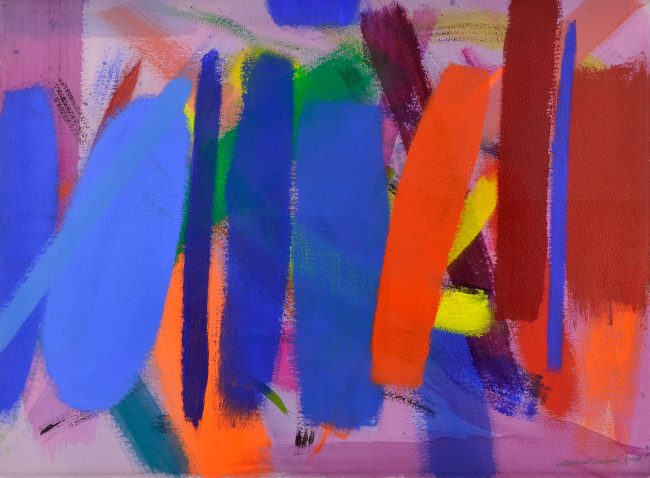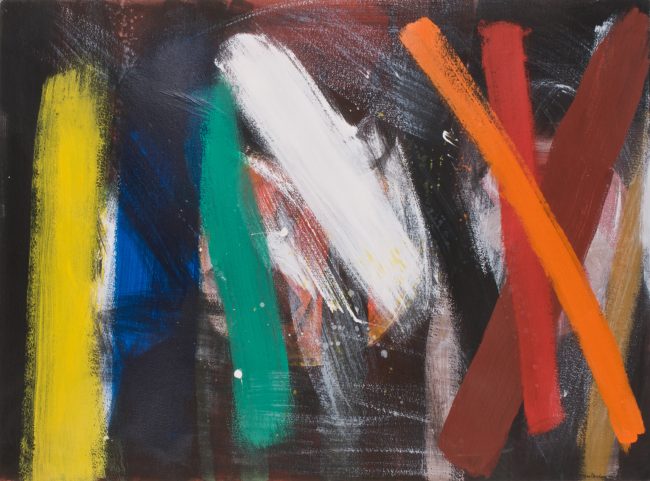The Scorpio Series

Blue Dance, 1998, Acrylic on paper, BGT949
THIS ARTICLE ACCOMPANIES THE ON-LINE DISPLAY – SCORPIO
The late paintings of Wilhelmina Barns-Graham are some of the most remarkable of her lengthy career.
Wilhelmina Barns-Graham’s career and reputation was boosted by an outpouring of paintings and prints made in her final decade. The Scorpio Series notably introduced a new dynamic to her art that was to lead to a further experimentation and in her own words, “letting rip.” In a conversation with John McEwen, art critic for the Daily Telegraph in 2001, her response on being asked to provide an artistic credo was the following:
“Now I am at the stage of urgency. My theme is celebration of life, joy, the importance of colour, form, space and texture. Brushstrokes that can be happy, risky, thin, fat, fluid and textured. Having a positive mind and constantly being aware and hopefully being allowed to live longer to increase this celebration.”
The selection of paintings of the Wilhelmina Barns-Graham Trust on-line display fully supports her statement and demonstrate this celebration of the last ten years of her productive life.
The importance of the Scorpio Series cannot be under-estimated. Anecdotally they are a direct result of punishing a sheet of paper with a flailing brush after a failed interview with a journalist, when suddenly Barns-Graham recognized the potential of the raw material within those furious slashes. Under disciplined guidance the initial experiments became more coherent as she brought proper structure to the forms. The energy explodes through the apparent spontaneity and the mobility of the slashes, coupled with a lifetime’s experience and knowledge of colour. There are visible risks taken in her juxtaposition of colours, for her palette utilized the entire colour spectrum. Only an artist with remarkable skill can carry off some of the unlikely combinations she created. Indeed, not all of them did succeed and she destroyed the failures at once. Working on paper and using the best acrylic paints available (Lascaux), allowed her to express her individuality at full tilt, without tensing up or being precious about what she was making. Mistakes as well as successes were part of the process of moving her art forward.
There is a real sense of improvisation in the late works where a carefree effortlessness prevails. Barns-Graham was wont to work on several sheets of paper simultaneously, allowing each to evolve in its own way. The challenge for her was to recognize the moment when the work was finished, when the image received the final mark that made it ‘sing’. Working in this manner encouraged groups of paintings to become series. This aspect of her art is detectable throughout her career; to reiterate her words – “I tend to work in themes”. Barns-Graham fully explored ideas, letting them take her where they would, eventually re-shaping them in new ways.
By far the majority of Barns-Graham’s late paintings were made on paper with a relatively few works done on canvas. She often commented on the need to paint on a scale that sat well next to her peers and counterparts, and when she mentioned this it was with artists like Terry Frost and John Hoyland in mind. Large scale does impress and there is more than just subliminal thought in believing that a large painting is more important than a small one. However, during the 1990s, when Barns-Graham was in her eighties, the physical strength required to make large paintings on canvas was all but beyond her. Diminutive in stature from the outset, wielding large brushes over over-sized canvases was hugely difficult for her. The giant single and double sweeping brushstrokes encountered in the canvases of Easter Series (2000-2001) that measure 122 by 91 centimetres reflect her ambition to compete. Originally conceived large scale paintings, as opposed to images on paper enlarged to canvas, that show the artist to her best are rare in comparison to the works on paper. Indeed, at the end, Barns-Graham was looking to screenprint dedicated images on to large canvases as a means of resolving the physical demands of painting on the large scale.
Where the late works evoke or echo themes from previous decades, they lend a convincing consistency to her artistic credo when seen in its entirety. Evolutions take place over a period of years, not months, and it was never out of the question to re-visit past motifs. The Passing Forms Series from the late 1950s, for example, could be seen as a precursor for Scorpio Series style images though there is no way of being absolutely sure she re-encountered those paintings. It is known that Black Oval (1959) did spark her imagination when brought out for selection for the 1989 Edinburgh City Art Centre (ECAC) retrospective exhibition, so it is as likely that paintings from the Passing Forms Series were also reviewed at that time. Furthermore, one should not forget the expressive gouaches she made between 1958 and 1963 which were well represented in the ECAC exhibition; the freely applied brush marks are strikingly prophetic when seen next to late works.
Unsurprisingly, one can also find more immediate precursors of style and elements featuring in paintings from the 1980s and the first years of the 1990s. In Expanding Forms series of the early 80s, for example, bars of colour – described as rectangles or parallelograms – move rhythmically across the picture plane. Later in the decade these shapes are formed as pure brushstroke but are often more static, less energetic than what was to come. Nonetheless, the seeds of the Scorpio paintings are there to see. This is equally true of the heightened colour that Scorpio paintings are recognised for, which arose from her return to painting with gouache in her work of 1988 (see this separate display ‘Exhibition 1989 The Scottish Gallery London’) and her introduction to Lascaux’s aforementioned acrylic paints.
The sparks for the starting points for Scorpio can be considered therefore to stem from both revisiting past work as much as a continued development of the direction in which her painting was evolving. The failed interview was the catalyst for a more radical intervention. Whatever the truth of it, Barns-Graham’s late paintings reveal the same, fundamental dedication to resolving the problems of combining colour, shape and form that informs all of her practice. However, in her final decade, while in her eighties, the diversity of her creativity is truly astounding. The late flourish of experimentation came from her abiding resolve, her sense of urgency to make the very most of each day that remained.
A final word must go to acknowledge the large body of prints which Barns-Graham made in parallel with her painting within this last decade. These too contain fine examples connected with Scorpio Series, particularly two screenprints made with Kip Gresham(Blue Light, Summer and Summer (Yellow)) (1999) and several of her Time Series (1999). Scorpio variations extended to the Sunghrie and Red Playing Games series (2001), ultimately concluding with the Water Dance (Porthmeor) and Wind Dance prints (2003-04).
Geoffrey Bertram
August 2020

Scorpio Series No.1, 1995, acrylic on paper, 55.6 x 75.5 cm, BGT948
